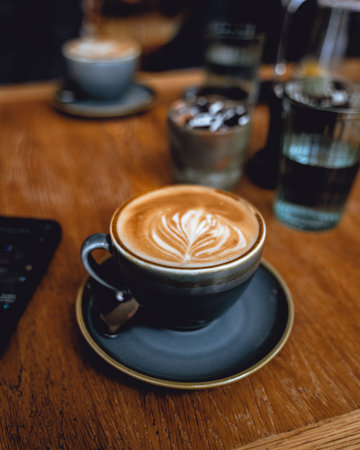Caffeinated Crossroads: The Emergence of Cold Brew in Britain
It’s a curious sight: the quintessential British café, once defined by its steaming teapots and frothy flat whites, now proudly displaying glistening bottles of cold brew on the counter. How did this cool, caffeinated concoction—once the preserve of trendy New York baristas and sun-drenched Australian brunch spots—make its way into the heart of Britain’s café culture? In a nation where the ritual of hot tea is woven into the fabric of daily life, and a builder’s cuppa is almost sacred, the rise of cold brew signals more than just a passing preference for something chilled. It whispers of shifting tastes and global influences that are reshaping how Britons experience their beloved cafés.
Timeless Tearooms vs. Modern Coffee Houses
To truly understand the rise of cold brew in the UK, one must first appreciate the rich tapestry of British café culture—a story woven through generations. Traditional tearooms evoke a sense of refined elegance: think floral china, clotted cream, and the gentle clink of teaspoons amidst hushed conversation. These classic spaces offer a sanctuary from the bustle of daily life, their charm grounded in ritual and tradition.
Fast forward to today, and a new energy pulses through Britain’s high streets. Modern coffee houses have emerged as vibrant social hubs, their open-plan interiors filled with laptop-tapping freelancers, friends catching up over flat whites, and now—enthusiasts sipping on chilled cold brew. The shift is palpable; while tearooms linger in nostalgia, contemporary cafés embrace minimalism and innovation, serving everything from single-origin espresso to nitro-infused cold brew.
| Classic Tearooms | Modern Coffee Houses | |
|---|---|---|
| Ambience | Elegant, quiet, tradition-rich | Bustling, trendy, creative |
| Beverages | Loose-leaf tea, scones, cakes | Espresso-based drinks, artisan pastries, cold brew |
| Clientele | Families, retirees, afternoon tea-goers | Younger crowd, remote workers, coffee aficionados |
| Design Aesthetic | Vintage décor, soft lighting | Minimalist design, industrial chic |
| Cultural Vibe | Quintessentially British, slow-paced | Global influences, fast-paced lifestyle |
This evolution reflects not just changing tastes but also broader shifts in British society. As global coffee trends land on UK soil—cold brew included—the lines between past and present blur. Whether you’re partial to the comforting rituals of a tearoom or drawn to the urban buzz of a modern café, there’s no denying that both worlds now find themselves sharing space in Britain’s ever-evolving café culture.
![]()
3. The Appeal: Why Are Brits Embracing Cold Brew?
Cold brew has captured the imagination of British café-goers in a way that few coffee trends have managed before. At the heart of its allure is the unique flavour profile—smooth, subtly sweet, and low in acidity—which offers a refreshing alternative to the robust punch of traditional espresso-based drinks. For many, the gentle extraction process, steeping coarsely ground beans in cold water for up to 24 hours, brings out delicate tasting notes that often go unnoticed in hot brews.
The Flavour Revolution
This nuanced taste speaks directly to a generation keen on exploring artisanal food and drink experiences. Cold brew’s versatility, whether served black over ice or blended with creamy oat milk, aligns perfectly with Britain’s growing appetite for creative coffee concoctions. Cafés now proudly showcase single-origin cold brews or infuse them with botanicals like orange zest and cardamom—reflecting both innovation and a playful approach to tradition.
A Ritual for Modern Lifestyles
Beyond flavour, cold brew dovetails seamlessly with the fast-paced urban lifestyles found in cities from London to Manchester. Its ready-to-drink nature means less waiting around for complex brewing rituals; it’s grab-and-go, yet still sophisticated. For those who cherish lingering at stylish cafés or working remotely with their laptops, cold brew offers a cool refreshment that feels both modern and distinctly cosmopolitan.
British Sensibility Meets Global Trend
Adopting cold brew doesn’t mean abandoning British café culture—it’s about adaptation and evolution. The relaxed, social atmosphere of UK coffee shops remains intact, but now there’s a new star on the menu, one that resonates with health-conscious millennials and Gen Z alike. Lower in bitterness and often less acidic than standard iced coffee, cold brew is easier on the palate and stomach—a subtle nod to British preferences for mellow comfort without sacrificing sophistication.
4. Cold Brew in the Daily Ritual: Fitting In or Standing Out?
When wandering through the winding streets of London, Manchester, or even Brighton, its impossible not to notice the ever-evolving landscape of British café culture. Yet, as cold brew appears on more chalkboard menus, it prompts a new question: is it truly blending into the daily rituals of British coffee drinkers, or does it remain an outsider—favoured only by the adventurous or trend-conscious?
To answer this, one must first understand the heart of the British café experience. Traditionally, cafés here are places for a comforting flat white or a classic English breakfast tea, sipped slowly amidst conversation and people-watching. The ritual is as much about the warm cup between your hands as it is about the drink itself. So where does icy cold brew fit in?
The Role of Cold Brew in Everyday Coffee Choices
| Aspect | Traditional British Café Drinks | Cold Brew Experience |
|---|---|---|
| Temperature Preference | Hot and soothing; ideal for chilly weather | Chilled and refreshing; suited for warmer days |
| Coffee Ritual | Sit-in, slow enjoyment; focus on comfort | Often grab-and-go; appeals to those seeking novelty |
| Main Audience | Broad demographic; all ages | Younger crowd; trendsetters and coffee aficionados |
| Menu Positioning | Mainstay classics (flat white, Americano) | Speciality or seasonal offering |
| Cultural Perception | Part of tradition and daily life | Seen as modern, sometimes even a bit continental or Americanised |
A Drink for Every Mood—or Just for Moods?
The table above highlights how cold brew stands apart from its hot counterparts. While its crisp taste can be a revelation during a rare British heatwave, it’s rarely the choice when clouds gather over the city. For many regulars at British cafés, cold brew remains a curious alternative—something to try on a whim rather than a fixture in their morning routine.
The Adventurous Few vs. The Traditional Majority
This divide is particularly evident in conversations overheard at local independent cafés. While some younger patrons might order cold brew with enthusiasm—seeking something bold and Instagram-worthy—many others stick faithfully to their cherished lattes and cappuccinos. In this way, cold brew is both fitting in as a seasonal delight and standing out as a badge of culinary curiosity.
5. Baristas & Brands: How Local Cafés Are Responding
British baristas have always been a creative breed, and the rise of cold brew has only fuelled their imagination. Across the UK, local cafés are taking the classic cold brew recipe and infusing it with a distinctly British twist. Think cold brew steeped with Earl Grey tea for a subtle bergamot note, or adorned with a splash of oat milk and honeycomb syrup—a nod to the nations love affair with sweet, creamy comforts. Some independent coffee shops are even experimenting with seasonal botanicals, like elderflower or rhubarb, to create limited-edition cold brews that capture the essence of a British summer.
Menu innovation is thriving as cafés compete not just on taste but also on presentation and experience. You’ll find nitro cold brew poured from taps—smooth, velvety, and reminiscent of a well-pulled pint at your favourite pub—or artisanal cold brew flights served in elegant glassware, inviting customers to compare single-origin beans side by side. These playful adaptations keep regulars coming back while enticing curious newcomers who may once have shunned iced coffee as an American novelty.
Meanwhile, well-known British brands are embracing this trend without sacrificing tradition. High-street chains offer cold brew alongside classic flat whites and builder’s tea, ensuring there’s something for every palate. They’re also mindful of sustainability—serving cold brew in recyclable cups or encouraging reusable vessels as part of their eco-friendly ethos.
The adaptability of British baristas is clear: they respect the roots of café culture while welcoming global trends with open arms (and keen palates). By spotlighting local ingredients and celebrating individuality in every cup, these cafés are making cold brew not just a passing fad but an integral part of Britain’s ever-evolving coffee scene.
6. A Fad or Here to Stay? Perspectives from Both Sides
As the aroma of cold brew drifts through Britain’s bustling cafés, opinions remain delightfully divided about its future. To gain a well-rounded perspective, we gathered viewpoints from café owners, loyal customers, and self-confessed coffee aficionados, each bringing their unique filter to the debate.
Café Owners: Embracing Experimentation
Many independent café owners see cold brew as more than just a passing craze. For them, it’s an opportunity to expand their menu and engage younger, adventurous clientele. “Cold brew allows us to be creative, offering everything from classic pours to nitrogen-infused concoctions,” notes Sophie, owner of a popular London coffee spot. However, some traditionalists remain cautious, pointing out that British weather hardly begs for iced drinks year-round and questioning whether cold brew will have staying power once novelty wears off.
Customers: Curious but Cautious
The British public is famously discerning when it comes to their cuppa. Many customers are intrigued by the smoothness and low acidity of cold brew, appreciating it as a refreshing alternative during warmer months. Yet, others hold fast to their milky flat whites and strong espressos, regarding cold brew as a seasonal treat rather than a staple. A regular at Manchester’s Northern Quarter tells us, “It’s fun in summer, but I can’t see myself swapping my morning latte for a cold brew in February.”
Coffee Aficionados: Divided Opinions
Within the passionate coffee community, debate runs deep. Purists sometimes scoff at cold brew’s lack of ceremony compared to a meticulously pulled espresso shot. Meanwhile, others embrace the technical artistry behind achieving the perfect overnight extraction and complex flavour notes. The consensus? Cold brew has earned its place as part of the British coffee lexicon—at least for now.
The Verdict: Trend or Tradition?
So, is cold brew destined to become a fixture in British café culture or simply another fleeting fad? The answer may lie somewhere in between. Its adaptability and appeal to younger consumers suggest lasting potential, but only time will tell if it becomes as quintessentially British as a pot of builder’s tea. For now, cold brew offers both a fresh twist for the curious and an ongoing conversation for coffee lovers across the UK.

